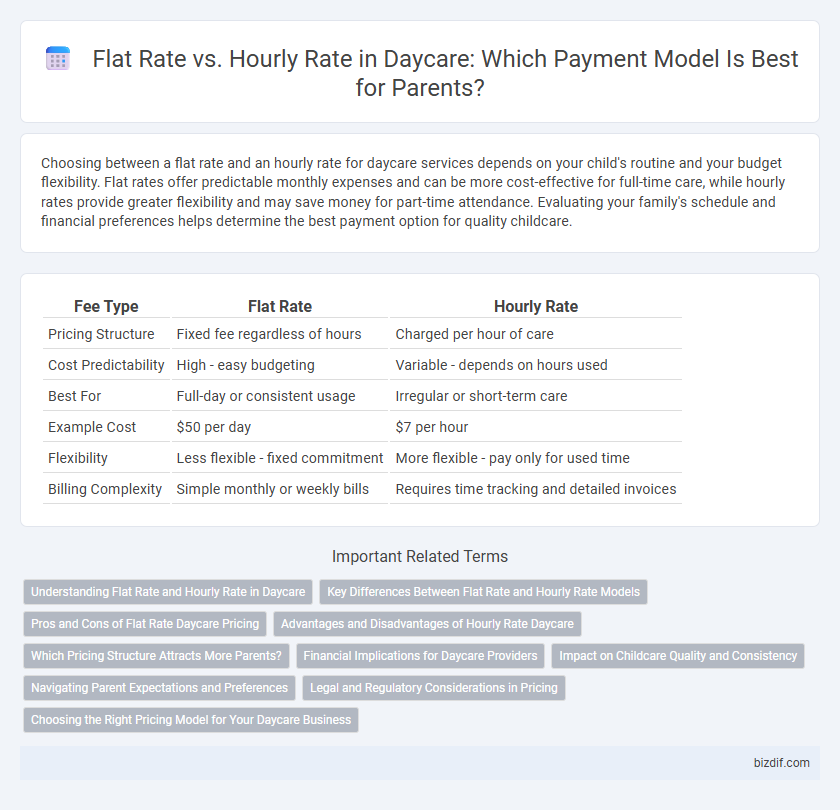Choosing between a flat rate and an hourly rate for daycare services depends on your child's routine and your budget flexibility. Flat rates offer predictable monthly expenses and can be more cost-effective for full-time care, while hourly rates provide greater flexibility and may save money for part-time attendance. Evaluating your family's schedule and financial preferences helps determine the best payment option for quality childcare.
Table of Comparison
| Fee Type | Flat Rate | Hourly Rate |
|---|---|---|
| Pricing Structure | Fixed fee regardless of hours | Charged per hour of care |
| Cost Predictability | High - easy budgeting | Variable - depends on hours used |
| Best For | Full-day or consistent usage | Irregular or short-term care |
| Example Cost | $50 per day | $7 per hour |
| Flexibility | Less flexible - fixed commitment | More flexible - pay only for used time |
| Billing Complexity | Simple monthly or weekly bills | Requires time tracking and detailed invoices |
Understanding Flat Rate and Hourly Rate in Daycare
Flat rate daycare pricing involves a fixed fee for a set period, typically covering full-day or weekly care, providing predictable costs for parents. Hourly rate billing charges parents based on the exact time their child spends in daycare, offering flexibility but resulting in variable expenses. Understanding these pricing models helps parents choose the most cost-effective and convenient option for their childcare needs.
Key Differences Between Flat Rate and Hourly Rate Models
Flat rate daycare pricing charges a fixed amount regardless of the time spent, providing predictable monthly expenses for families. Hourly rate models bill based on actual hours of care, offering flexibility for varying schedules but potentially higher costs during extended hours. Choosing between flat and hourly rates depends on a family's budget stability and childcare usage patterns.
Pros and Cons of Flat Rate Daycare Pricing
Flat rate daycare pricing offers predictable monthly costs, making budgeting easier for parents and reducing billing complexity for providers. However, it may not accommodate varying attendance patterns, potentially leading to overpayment if a child attends fewer days or undercharging if attendance fluctuates frequently. This pricing model simplifies administrative tasks but lacks the flexibility that hourly rates provide for irregular schedules.
Advantages and Disadvantages of Hourly Rate Daycare
Hourly rate daycare offers parents flexibility by charging only for the exact time their child spends in care, making it cost-effective for irregular schedules. However, hourly rates can lead to unpredictable monthly expenses, complicating budgeting for families with variable care needs. Providers may face administrative challenges tracking time precisely, potentially increasing operational complexity compared to flat-rate billing.
Which Pricing Structure Attracts More Parents?
Flat rate pricing in daycare services offers parents predictable monthly costs, making budgeting easier and often attracting families seeking consistent childcare expenses. Hourly rates appeal to parents with irregular schedules, providing flexibility but potentially resulting in higher overall costs. Studies show that flat rates tend to attract more parents due to financial certainty and straightforward billing, especially for full-time daycare users.
Financial Implications for Daycare Providers
Flat rate pricing for daycare providers offers predictable monthly income and simplifies budgeting, reducing administrative costs associated with tracking hours. Hourly rates can increase revenue during peak usage but may lead to income variability and more complex billing processes. Providers must balance consistent cash flow with potential earnings when choosing the optimal rate structure.
Impact on Childcare Quality and Consistency
Flat rate childcare fees promote consistent quality by providing stable funding that supports structured routines and skilled staff retention, enhancing overall child development. Hourly rates may lead to fluctuating attendance, which can disrupt children's sense of security and impede the formation of strong caregiver-child relationships. Consistent payment models enable daycare centers to plan resources effectively, directly impacting the reliability and quality of care offered.
Navigating Parent Expectations and Preferences
Flat rate daycare pricing offers predictability and simplifies budgeting for parents by providing a consistent monthly fee regardless of hours used. Hourly rate structures appeal to families with irregular schedules seeking flexibility and pay only for actual care time, aligning costs with usage. Understanding these preferences enables daycare providers to tailor pricing models that meet diverse parent expectations while maintaining operational efficiency.
Legal and Regulatory Considerations in Pricing
Daycare providers must adhere to state and local regulations that often influence pricing structures, making flat-rate fees more straightforward for compliance with licensing requirements and subsidy programs. Hourly rates may require meticulous record-keeping and reporting to meet legal standards, increasing administrative burden and risk of non-compliance. Understanding relevant child care laws and financial regulations is essential to ensure transparent and legally compliant pricing policies in both flat and hourly rate models.
Choosing the Right Pricing Model for Your Daycare Business
Choosing the right pricing model for your daycare business involves evaluating Flat Rate and Hourly Rate structures based on client needs and operational costs. Flat Rate pricing offers predictable income and simplifies billing, ideal for families seeking consistent scheduling, while Hourly Rate grants flexibility for varying attendance, appealing to part-time or irregular clients. Analyzing local market trends, competitor pricing, and your daycare's capacity helps optimize profitability and customer satisfaction.
Flat Rate vs Hourly Rate Infographic

 bizdif.com
bizdif.com